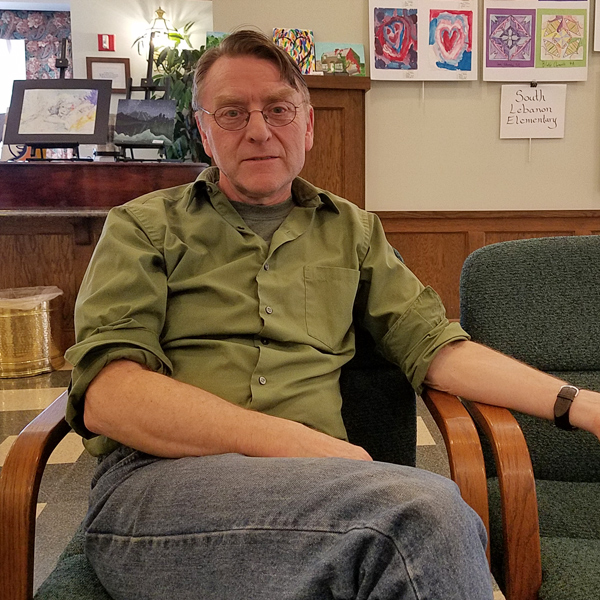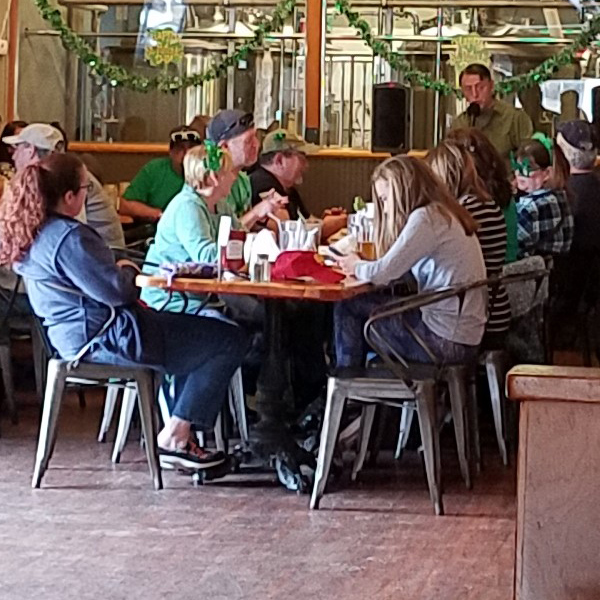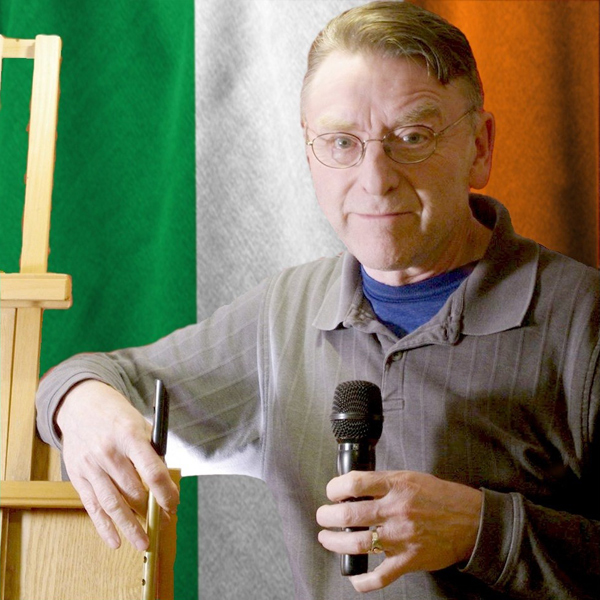About Seamus Carmichael:
Seamus Carmichael of Lebanon, PA is a singer of traditional Irish music. In July 2020, he spoke with folklorist Amy Skillman about how he found his roots with Irish traditional music, what’s special about sean-nós singing, and why his music is so important to him.
His name is pronounced SHAY-mus CAR-mike-uhl.

portrait of Seamus Carmichael courtesy of the artist
About Seamus Carmichael
Singing at a session
Music in the family
If you ask Seamus Carmichael how he got into singing traditional Irish music, he will tell you, “It is in the family. My mother was a genuine traditional singer. Growing up in a little farming community in the north of Ireland with the church as the social center of your life ... my mother would be asked to sing.” But, like most young people eager to blaze their own trail, he didn’t think much of it at the time. He preferred the music of Horslips, Steeleye Span and Planxty — bands who were drawing on traditional music but recasting it into the new Irish folk and folk rock formats of the times.
“Singers like Christy Moore of Planxty and Maddy Prior of Steeleye Span were a great inspiration to me in terms of the story songs they would sing.” Seamus notes that Christy Moore introduced him to the Child Ballads, a collection of over 300 Scottish and English ballads from the mid-19th Century “which I realized as I got a little bit more into it, were collected in the part of the world where I grew up.” Suddenly his mother’s songs made sense and became important to him. He is also inspired by Cathal McConnell from The Boys of the Lough, and Paddy Tunney “who was possessed of an angel’s voice... aah, his voice would just make you weep, it was so beautiful”.
Seamus grew up near Bellaghy, County Derry in the north of Ireland. In 1978 he graduated from the College of Art in Belfast, specializing in print making. He has won awards and scholarships for his work, which he often uses to illustrate Irish subjects, such as poetry and songs. Marriage brought him to the US in 1984. He lived in Philadelphia and on Long Island before settling in Lebanon, PA. He has served for many years on the board of Lebanon Valley Council on the Arts and promotes artists and arts activities in the community through a variety of programs. He taught art and art history in local colleges and schools for many years. Now he works at the library of the Hershey Medical Center as Library Lead, running their circulation desk and doing graphic design work.

photo of Seamus Carmichael by Amy Skillman
What is sean-nós?
Seamus is an a capella singer in the Irish tradition. He plays the tin whistle and harmonica but is primarily a singer. He says, “If you’re in a seisún pub (a pub that holds gatherings of musicians to play music together) in Ireland or Scotland and somebody shouts ‘singer in the house?’ everybody shuts up.” Songs range from rowdy pub songs to humorous stories, but it is the traditional sean-nós (SHAN-ohss) song that people will hush their conversations to hear. This highly ornamented song is sung in the Irish language and often evokes emotions of longing. Singers perform many genres of song, but most sean-nós are love songs.
“My definition, after singing that style for many years, is that it is an art song but from a folk tradition.” He explains that a good singer is assessed by the amount of emotion and expression they can put into the song. The singers will often sing with their eyes closed. “Every time a sean-nós song is sung, it’s a new creation because the singer, he’s not sticking to the script. He knows where he’s going, but how he gets there is up to him. He can mess with the timing in the song. One of the things in sean-nós is it’s not strictly on the beat. It’s an improvisation. It’s the singer having a conversation with his audience, but also, melodically, he’s having a conversation with the text of the song. So what you do with your voice that emphasizes that emotion or narrative within the song is also part of the artistry of singing that style.” He likens it to what a jazz singer does.
A sean-nós song might have two layers of meaning. One song Seamus likes to sing is Róisín Dubh (Dark-Haired Little Rose, pronounced roe-sheen DOOV”). It is both a passionate love song and a political song from the late 16th century. It was reputedly written for one of the Irish chieftains by his bard when they were exiled in Spain after being chased out of Ireland by the English. The song returned to Ireland and became an inspiring “undercover” political song.
Pub songs and sessions
Seamus also leads pub singalongs and loves to sing comic songs. He says, he has one thing going that lots of singers don’t have — he is loud and therefore able to be heard above the usual chatter in a pub. Seamus acknowledges that a lot of what he does is stagecraft. “You learn to wait for the audience to laugh, reinforce the story by your body movements, and pause in the right places. You learn those things, especially if you are singing in a crowded bar.”
He returned to his roots as a singer, singing in public, in 2005. He learned about an Irish music session (the English word for seisún) happening in Lebanon and decided to go.
“When I went to that first session, nobody was singing. I expect singers at a session. So I started singing the songs that I knew from Planxty, Steeleye Span and the Clancy Brothers.” He encountered a number of local musicians who played in the Irish tradition and soon became the person organizing sessions in town. Now, there are about half a dozen sessions locally in Richland, Lancaster, Hershey, Gettysburg, and Carlisle. You could participate in something every weekend, and Seamus does.
“It’s not like the Irish tradition has died and needs to be revived. It is a very healthy ongoing tradition... In fact, Irish music is completely international. It’s grown legs. People all over the world like to play it. I’m told there are three sessions a week in Seoul, South Korea.” He jokes, “For Irish musicians, we call St. Patrick’s Day the High Holidays, because for most of the year we play music for ourselves for free in pubs.”
If Irish music reaches across cultures, Seamus attributes it to the fact that listeners can see themselves in the words. As an example, he offers some of the lyrics to “The Parting Glass” — a song he usually reserves for the end of his set.
Of all the money that e’er I had, I spent it in good company...
Of all the harm I’ve ever done, alas it was to none but me...
Of all the friends I’ve ever had, they are sorry for my going away...
Of all the sweethearts e’er I had, they’d wish me one more day to stay...
He says, “Lines like that speak to people regardless of their ethnicity... They see it as ‘the story of my life’.” The popularity can also be explained by the fact that Irish music lends itself to people listening and joining in. The typical Irish session involves everyone taking a turn with a tune and people joining in if they know the tune or listening until they do know it. “It’s all playing by ear... about playing what you remember and teaching it to somebody else... We play acoustic music so if you are at the other end of the bar you’re not going to be deafened by it. But if you sit up close, you’ll get into it.”
Of sean-nós singing, he says, “I’m not sure you can learn it unless by immersing yourself in it and seeing what the singers are doing... when you actually hear somebody singing these songs, and you try to emulate that, you are then learning what they’re doing as well.” In this way, you not only learn the words, but the ornamentation style and technique. He notes, “If you’re doing a slow song, a song where the melody can be attenuated, there’s a certain tendency to smooth stuff out and to make it flow really well, which I would say is characteristic of traditional Irish singing... It has a melancholy that is typical of Irish songs. That quality of making the transition from note to note smooth and ornamenting the passage from one note to the other, is very much a part of what I would say is the Irish voice.” Scholars of Irish music call this melisma — singing one syllable of text over several notes of music.

photo by Amy Skillman
Writing songs in the tradition
Seamus has also tried his hand at song writing, in the Irish tradition. As he explains, putting new words to old tunes is part of the folk tradition. The melodies of many newer songs are built on older harp tunes. He offers “Danny Boy” as an example. The melody was documented in the late 1700s when Edward Bunting began his collection of harp tunes in an effort to save the repertoire. Harp tunes had always been believed to lend inspiration and valor to the chieftains and aristocracy. In fact, during earlier Elizabethan times, many harpists were killed in order to disrupt the support they gave the rebel chieftains. By the 1700s, most of the harpers had been deprived of their patrons by the English when they displaced the native aristocracy. Bunting began his collection during the Belfast Harp Festival in 1792 and continued into the 1800s, creating three volumes of The Ancient Music of Ireland. The lyrics to “Danny Boy,” on the other hand, were written in 1910 by Frederic Weatherly, an English barrister. It wasn’t until 1913 that he set his words to the much older harp tune known as “Londonderry Air.” As Seamus says, “the words revived the older melody.”
In 2011 or 2012, Seamus used this same process to write lyrics to the tune “The Road to Lisdoonvarna.” He was playing with a group of musicians and, at the end of playing that song, someone said, “There ought to be words to that.” He took the challenge and began rifling through stories in his own life to create the story for the song. He recalled a matchmaking fair in Lisdoonvarna and drew on the memory of his bachelor farmer Uncle James as inspiration for his lyrics. It’s the story of a farmer who goes to the month-long festival of dances to find a wife, but leaves without having succeeded. On the road home, he meets a woman who’s had the same disappointing experience and they discover they are a perfect match. Seamus chose to challenge the stereotype that all Irish ballads end in sadness by giving his a happy ending.
When asked why this music is so important to him, Seamus says, “...I made sure that each of my kids learned a song or was able to play a tune; that they would have that part of their father’s heritage as part of their growing up... And, when you’re an immigrant, it is as a connection to your identity, it brings out that part. Also the connection with the music gives you an "in" whenever you go back to Ireland. If I go back to Ireland, I’m going to hang out with my musician friends. I’ll go to bars with them and we’ll sit and play music and I’ll sing songs. It’s like you’re still part of that community. And over here it’s very much a social community. I count among my good friends, the people I play music with regularly.”
Seamus especially appreciates all the younger musicians who have “caught the bug” and become infected with Irish music. “Folks like that will listen to an older singer like me and say, ‘Oh, that’s a cool song. I’d like to try that one myself.’ That’s my audience, and those are the people that will carry that particular tradition on.”

portrait of Seamus Carmichael, courtesy of the artist
Hear Irish music and song in Central PA
Seamus can be seen performing every month at Irish traditional music sessions in Central PA. His favorites are:
- Annie Bailey’s (Lancaster) 2nd Sunday of the month, 2-5 PM
- Tellus360 (Lancaster) 4th Sunday of the month, 2-5 PM
- Union House Taproom (Richland) 3rd Saturday of the month, 5-7 or 8 PM
- Ugly Oyster Bar (Reading) every Thursday, 6-9 PM
- The Garryowen (Gettysburg) 1st & 3rd Sundays, 2-5 PM
To find an Irish music session in your part of the world, check out TheSession.org. To learn more about Seamus and find out about Irish sessions in Central PA, visit Seamus’s website.
Just days after this interview in March 2020, the Irish music session scene (worldwide!) was seriously disrupted by the COVID-19 pandemic. Many sessions were displaced, either temporarily or permanently. Keep an eye on Seamus’s website for updates.



Brand icons for Facebook, YouTube, Instagram and other social media platforms are the trademark of their respective owners. No endorsement is implied.